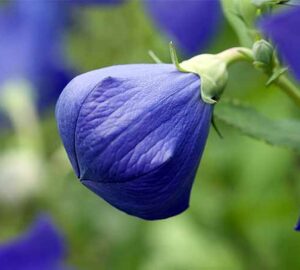 About 1,000 years ago, or in 1967, to be specific, the Fifth Dimension, a pop group, recorded “Up, Up, and Away,” a song about bout love and ballooning. The refrain goes, “Up, up and away–My beautiful, my beautiful balloon.” It was a huge hit, combining the ideas of love, hot air, and rising above earthly concerns
About 1,000 years ago, or in 1967, to be specific, the Fifth Dimension, a pop group, recorded “Up, Up, and Away,” a song about bout love and ballooning. The refrain goes, “Up, up and away–My beautiful, my beautiful balloon.” It was a huge hit, combining the ideas of love, hot air, and rising above earthly concerns
I don’t have a lot of hot air in the garden—at least right now—but I put a lot of love into it, and doing so helps me rise above earthly concerns. Balloon flowers, known botanically as Platycodon grandiflorus, help me do that, and they will bloom in the six weeks or so, depending on the vagaries of spring and early summer weather.
The perennial plants sprout from the earth, eventually producing stems that may be anywhere from 18 to 36 inches tall, topped by the puffed, rounded buds that give the plants their common name. The ‘balloons” open into the flattened, bell-like flowers that inspired the botanical Latin genus name. Lovers of ancient Greek will remember that “platy”–as in platypus, a flat-billed marsupial–means “flat”. Put “platy” together with “codon”, meaning “bell” and you have a great description of these beautiful flowering plants.
Though their mass-market popularity waxes and wanes, balloon flowers are perennial favorites in both senses of those words. The blooms always come along at just the right time in the horticultural year, when the showy clumps of Shasta daisies are nearly finished. If you have had plenty of rain, you will probably have a plethora of other flowers, including roses in their second flush, coneflowers, gazillions of daylilies and flowering annuals. But if rain has been sparse and irrigation haphazard–a situation that is often more perennial than the weeds at my place–the late daylilies, well-established coneflowers and early roses-of-Sharon will be just about the only floral competition. Balloon flowers, in shades of blue-purple, pink and white are an especially good color match for the roses-of-Sharon and have the advantage of attracting attention a little closer to ground level.
Every balloon flower starts from a fleshy root, which traditional healers have used to treat a variety of respiratory and inflammatory ailments. The stems, filled with milky sap, sprout blue-green leaves that are somewhat whorled around the stems’ bases and alternate farther up. The “balloons” appear at the tops or ends of the stems, with about twenty percent of the buds on each stalk blooming at any one time. The overall look is a little less floriferous than that of some other plants, but the bloom season goes on longer. Rounded seedheads turn a lovely, steely blue, adding interest even when the floral balloons are long gone.
Balloon flowers belong to the large Campanulaceae or bellflower family. If you have a mixed perennial/annual/shrub border, as I do, you probably grow many balloon flower relatives from little ‘Blue Clips’ Carpathian harebells—Campanula carpatica–to the gorgeous peach-leaf bellflower or Campanula persicifolia. All of them like similar conditions, including full sun to very light shade, and nice, rich loam. Balloon flowers form clumps if they are happy and, in my experience, they are moderately drought tolerant once established. Just about the only downside to the taller varieties is that they sometimes flop over, especially in bad weather. Stake the entire clump to keep the balloons aloft or, alternately, if you are vigilant in spring, cut back the stalks by about one third in May. This move, known to English gardeners as “the Chelsea chop”, delays the bloom time, but results in shorter stalks that may not need staking.
The best known balloon flower variety is the old-fashioned ‘Mariesii’, first cited in American sources in 1806. The plants which feature large, blue-purple flowers, was awarded the Royal Horticultural Society’s Award of Garden Merit for outstanding garden performance. English writer and gardener Vita Sackville-West used the harder-to-find white form, ‘Mariesii Alba,’ in her famous white garden at Sissinghurst. For something a bit more lush, try tall, double-flowered varieties like ‘Hakone Blue’ and ‘Hakone White’ or the shorter double-flowered Astra varieties. The balloon-shaped buds are the same as those of single-flowered types, but the petal count is higher when the flowers open.
Gardeners who plant in pots or small-space situations should investigate the Astra series, varieties that come in pink, white or blue-purple and grow only eight to ten inches tall. ‘Sentimental Blue’ is slightly smaller still and has fared well in botanical gardens and plant trials.
Flower arrangers love balloon flowers. If you have a yen to cut a few stems for indoor display, singe the stem ends with a match or flame to staunch the flower of sap. Once that is done, the blooms last very well.
At this time of the year, you may be able to find Platycodon grandiflorus at nurseries. The Astra series is available in some places where Proven Winners plants are sold. If you can’t find them locally, many Etsy vendors list them For single-flowered types, go to Bluestone Perennials, 7211 Middle Ridge Road, Madison, OH 44057; (800) 852-5243; www.bluestoneperennials.com. Print catalog available.
